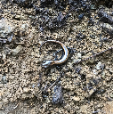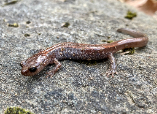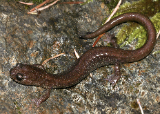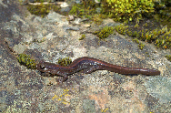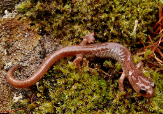Scott Bar Salamander (Plethodon asupak)
Description: P. asupak is a moderate-sized, robust salamander with long limbs growing to a snout-to-vent length of 2.4 inches for males and 2.6 inches for females. It has a broad brown or bronze dorsal stripe and is otherwise purplish-gray with white flecks that condense on the sides and limbs into larger patches. The underparts are dark gray or purplish mottled with paler gray and flecked with white. It frequently has gold spotting on its otherwise black irises. Juveniles have paired, reddish dorsal stripes.
Habitat: Associated with rocky forested areas, especially thick moss-covered talus.
Range: A species endemic to California, it inhabits shaded, moss-covered talus slopes in old-growth mixed evergreen and montane fir forests of the Klamath Mountain Range. It was discovered in 2001, and is currently known from a few locations near the confluence of the Klamath and Scott Rivers, hence its common name Scott Bar salamander. Its range is only 13 miles at its greatest dimension. Known elevations extend from 2,300 to 4,300 feet above sea level.
Found in these States:
CA
Diet: Little is known about the diet of this species. The diets of the related allopatric species Plethodon species consist primarily of small invertebrates, including spiders, mites, beetles, and moths.
Reproduction: Little is known about the breeding behavior of this species. Reproduction is terrestrial. If breeding in P. asupak is similar to the related allopatric species P. stormi, mating probably occurs in the spring, with females laying eggs in underground nests in spring or early summer and brooding them until fall. Females lay eggs. Young develop completely in the egg, hatch fully formed and probably remain underground until the following spring.
Status: Listed as Endangered because its extent of occurrence (EOO) is 648 km2, it occurs in five or fewer threat-defined locations, and there is continuing decline in the extent and quality of its habitat.
»» Kingdom: Animalia - Animals
»» Phylum: Chordata - Chordates
»» Subphylum: Vertebrata - Vertebrates
»» Class: Amphibia - (Amphibians)
»» Order: Caudata - Salamanders
»» Family: Plethodontidae - Lungless Salamanders
»» Genus: Plethodon
»» Species: Plethodon asupak - Scott Bar Salamander
This article uses material from the Wikipedia article "Scott Bar Salamander", which is released under the Creative Commons Attribution-Share-Alike License 3.0. Content may have been omitted from the original, but no content has been changed or extended.
|



